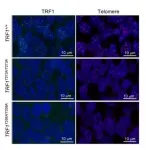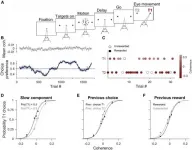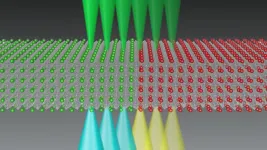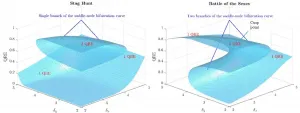New study links protein causing Alzheimer's disease with common sight loss
2021-03-10
(Press-News.org) Newly published research has revealed a close link between proteins associated with Alzheimer's disease and age-related sight loss. The findings could open the way to new treatments for patients with deteriorating vision and through this study, the scientists believe they could reduce the need for using animals in future research into blinding conditions.
Amyloid beta (AB) proteins are the primary driver of Alzheimer's disease but also begin to collect in the retina as people get older. Donor eyes from patients who suffered from age-related macular degeneration (AMD), the most common cause of blindness amongst adults in the UK, have been shown to contain high levels of AB in their retinas.
This new study, published in the journal Cells, builds on previous research which shows that AB collects around a cell layer called the retinal pigment epithelium (RPE), to establish what damage these toxic proteins cause RPE cells.
The research team exposed RPE cells of normal mouse eyes and in culture to AB. The mouse model enabled the team to look at the effect the protein has in living eye tissue, using non-invasive imaging techniques that are used in ophthalmology clinics. Their findings showed that the mouse eyes developed retinal pathology that was strikingly similar to AMD in humans.
Dr Arjuna Ratnayaka, a Lecturer in Vision Sciences at the University of Southampton, who led the study said, "This was an important study which also showed that mouse numbers used for experiments of this kind can be significantly reduced in the future. We were able to develop a robust model to study AMD-like retinal pathology driven by AB without using transgenic animals, which are often used by researchers the field. Transgenic or genetically engineered mice can take up to a year and typically longer, before AB causes pathology in the retina, which we can achieve within two weeks. This reduces the need to develop more transgenic models and improves animal welfare."
The investigators also used the cell models, which further reduced the use of mice in these experiments, to show that the toxic AB proteins entered RPE cells and rapidly collected in lysosomes, the waste disposal system for the cells. Whilst the cells performed their usual function of increasing enzymes within lysosomes to breakdown this unwanted cargo, the study found that around 85% of AB still remained within lysosomes, meaning that over time the toxic molecules would continue to accumulate inside RPE cells.
Furthermore, the researchers discovered that once lysosomes had been invaded by AB, around 20 percent fewer lysosomes were available to breakdown photoreceptor outer segments, a role they routinely perform as part of the daily visual cycle.
Dr Ratnayaka added, "This is a further indication of how cells in the eye can deteriorate over time because of these toxic molecules collecting inside RPE cells. This could be a new pathway that no-one has explored before. Our discoveries have also strengthened the link between diseases of the eye and the brain. The eye is part of the brain and we have shown how AB which is known to drive major neurological conditions such as Alzheimer's disease can also causes significant damage to cells in retina."
The researchers hope that one of the next steps could be for anti-amyloid beta drugs, previously trialled in Alzheimer's patients, to be re-purposed and trialled as a possible treatment for age-related macular degeneration. As the regulators in the USA and the European Union have already given approval for many of these drugs, this is an area that could be explored relatively quickly.
The study may also help wider efforts to largely by-pass the use of animal experimentation where possible, so some aspects of testing new clinical treatments can transition directly from cell models to patients.
This research was funded by the National Centre for the Replacement Refinement & Reduction of animals in research (NC3Rs). Dr Katie Bates, Head of Research Funding at the NC3Rs said:
"This is an impactful study that demonstrates the scientific, practical and 3Rs benefits to studying AMD-like retinal pathology in vitro."
INFORMATION:
Animal studies were overseen by the institutions' Ethical Research Committee and carried out in accordance with the UK Animal (Scientific Procedures) Act of 1986. Experiments also conformed to the ARVO statement for the Use of Animals in Ophthalmic and Vision Research. The experimental protocol was approved by the University of Southampton Research Ethics Committee and work carried out under the UK Home Office project licence #P395C9E5F (licence approval date: 4 July 2016).
ELSE PRESS RELEASES FROM THIS DATE:
2021-03-10
The Telomeres and Telomerase Group led by Maria A. Blasco at the Spanish National Cancer Research Centre (CNIO) continues to make progress in unravelling the role that telomeres -the ends of chromosomes that are responsible for cellular ageing as they shorten- play in cancer. The CNIO team was among the first to propose that shelterins, proteins that wrap around telomeres and act as a protective shield, might be therapeutic targets for cancer treatment. Subsequently, they found that eliminating one of these shelterins, TRF1, blocks the initiation and progression of lung cancer and glioblastoma in mouse models and prevents glioblastoma stem cells from forming secondary tumours. Now, in a study published in PLOS Genetics, ...
2021-03-10
People with aphantasia - that is, the inability to visualise mental images - are harder to spook with scary stories, a new UNSW Sydney study shows.
The study, published today in Proceedings of the Royal Society B, tested how aphantasic people reacted to reading distressing scenarios, like being chased by a shark, falling off a cliff, or being in a plane that's about to crash.
The researchers were able to physically measure each participant's fear response by monitoring changing skin conductivity levels - in other words, how much the story made a person sweat. This type of test is commonly ...
2021-03-10
WESTMINSTER, Colorado - March 10, 2021 - The paperbark tree (Melaleuca quinquenervia) was introduced to the U.S. from Australia in the 1900s. Unfortunately, it went on to become a weedy invader that has dominated natural landscapes across southern Florida, including the fragile wetlands of the Everglades.
According to an article in the journal END ...
2021-03-10
ften, humans display biases, i.e., unconscious tendencies towards a type of decision. Despite decades of study, we are yet to discover why biases are so persistent in all types of decisions. "Biases can help us make better decisions when we use them correctly in an action that has previously given us great reward. However, in other cases, biases can play against us, such as when we repeat actions in situations when it would be better not to", says Rubén Moreno Bote, coordinator of the UPF Theoretical and Cognitive Neuroscience Laboratory.
In these cases, decisions are guided by tendencies, or inclinations, that do not benefit our wellbeing. For example, playing the lottery more regularly after winning ...
2021-03-10
Recent studies estimate that we use an astounding 129 billion face masks globally every month - that is 3 million a minute. Most of them are disposable face masks made from plastic microfibers.
- With increasing reports on inappropriate disposal of masks, it is urgent to recognize this potential environmental threat and prevent it from becoming the next plastic problem, researchers warn in a comment in the scientific journal Frontiers of Environmental Science & Engineering.
The researchers are Environmental Toxicologist Elvis Genbo Xu from University of Southern Denmark and Professor of Civil and Environmental Engineering ...
2021-03-10
Global targets to improve the welfare of people across the planet will have mixed impacts on the world's forests, according to new research.
The United Nations' 17 key areas for global development - known as the Sustainable Development Goals (SDGs) - range from tackling poverty, hunger and sanitation to promoting clean energy, economic growth and reducing inequality.
Many of these goals, such as improved peace and justice, good health and wellbeing, and quality education, will have a positive impact on the Earth's natural forests.
But others, including creating new roads, industry and infrastructure, ...
2021-03-10
Nearly 100 percent of the red snapper sampled in the Gulf of Mexico over a six-year period by University of South Florida (USF) marine scientists showed evidence of liver damage, according to a study reported in Aquatic Toxicology.
The study is the first to correlate the concentration of crude oil found in the workhorses of the digestive system -- the liver, gall bladder, and bile - with microscopic indicators of disease, such as inflammation, degenerative lesions, and the presence of parasites. The team sampled nearly 570 fish from 72 Gulf locations between 2011 to 2017 in the wake of the historic 2010 Deepwater Horizon oil spill.
"The results add to the list of other species we've analyzed indicating early warning ...
2021-03-10
In a breakthrough for quantum computing, University of Chicago researchers have sent entangled qubit states through a communication cable linking one quantum network node to a second node.
The researchers, based in the Pritzker School of Molecular Engineering (PME) at the University of Chicago, also amplified an entangled state via the same cable first by using the cable to entangle two qubits in each of two nodes, then entangling these qubits further with other qubits in the nodes.
The results, published February 24, 2021 in Nature, could help make quantum computing more feasible and could lay the groundwork for future quantum communication networks.
"Developing methods that ...
2021-03-10
"Phase transitions" are a central phenomenon in physical sciences. Despite being technical-sounding, they are actually something we all experience in everyday life: ice melting into liquid water, or hot water evaporating as steam. Solid, liquid, and gas are three well known "phases" and, when one turns into another, that is a phase transition.
Rare-earth nickelate oxides, also called nickelates, have attracted a lot of interest from researchers because they display an electronic phase transition, which may be exploited in future electronic devices. This particular phase transition consists of turning from a metallic ...
2021-03-10
Game theory is known to be a useful tool in the study of Machine Learning (ML) and Artificial Intelligence (AI) Multi-Agent interactions.
One basic component of these ML and AI systems is the exploration-exploitation trade-off, a fundamental dilemma between taking a risk with new actions in the quest for more information about the environment (exploration) and repeatedly selecting actions that result in the current maximum reward or (exploitation).
However, the outcome of the exploration-exploitation process is often unpredictable in practice and ...
LAST 30 PRESS RELEASES:
[Press-News.org] New study links protein causing Alzheimer's disease with common sight loss







